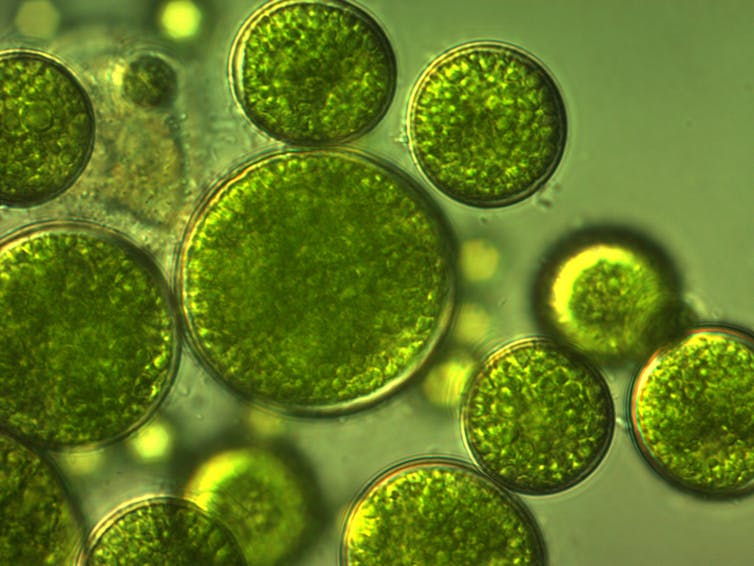by Daniel Svensson, Linnaeus University
Microalgae can recover greenhouse gases and nutrients from industrial waste. This technology can be used to reduce climate footprint and eutrophication. Lina Mattsson’s dissertation in ecology shows that microalgae can be used also in the Nordic climate, which has previously been considered a challenge as the algae are dependent on heat and sunlight.

The technology, which Linnaeus University’s research group Algoland has worked with for a long time, involves leading emissions into cultivation containers, so-called photobioreactors, containing microalgae. Through photosynthesis, the algae can recover substances like carbon dioxide, nitrogen, and phosphorus, and transform these into valuable biomass instead of having them disperse in nature. The green algal biomass mass is valuable as it contains large quantities of proteins, carbohydrates, and lipids.
“The algal biomass can be used for products that are of benefit to society, like biofuel, feed, cosmetics, and food supplements. In this way, microalgae can contribute to solutions for a more circular society”, explains Lina Mattsson, researcher in ecology.
Promising results
Lina Mattsson’s dissertation provides several positive answers to challenges that arise when algal cultivations are brought from the laboratory to large-scale outdoor cultivations in the Nordic climate. It shows that cold temperatures and a shortage of sunlight is not as big an obstacle as was previously feared.
The Nordic climate is considered challenging as most microalgae thrive in warm environments with plenty of sunlight. When conditions are good, more algae grow, meaning that more emissions can be captured and transformed into valuable biomass.
“The Nordic climate is a challenge for the cultivation of microalgae. However, the results from my dissertation show that there are good opportunities to cultivate microalgae in the Nordic climate to recover industrial waste”, Mattsson says.
She has studied how large-scale outdoor cultivations with industrial waste as nutrient resource function from an annual, seasonal, and diurnal perspective. Focus has been on the algae’s potential to recover emissions, and how the quality of the biomass changes over the year. After five years of cultivation, the results are positive.
The algae can be adapted to the Nordic climate
One way of meeting the variations in light, temperature and nutrients over the year is to mix several different types of algae that thrive under different conditions.
Stay Always Informed
Join our communities to instantly receive the most important news, reports, and analysis from the aquaculture industry.
“This proved beneficial as there were shifts in what species dominated depending on the season and external factors. The mixed algae community was better equipped to meet changes as the different species have different needs when it comes to light and nitrogen”, says Mattsson.
The cold temperatures of the winter season constitute the greatest obstacle. But also here, there are good opportunities to succeed through collaboration between research and industries. Such an example is the test facility that uses emissions from KalmarEnergi.
“During the coldest period in one of my studies, waste heat recovery from KalmarEnergi was beneficial for the algae as this helped keeping the temperature in the ponds at a good level. This is one of many examples of the utility that can be achieved through such collaborations”, Mattsson explains.
Valuable biomass
The Nordic climate also has its advantages. A part study shows that shifts in temperature between day and night increased the production of valuable lipids and proteins in the algae. When the production of biomass decreased in autumn due to lower temperatures and poor light conditions, this was compensated by a higher quality of the biomass.
“In our climate, these shifts in temperature between day and night are biggest during autumn and spring. Autumn is a period that can be challenging also due to poor light conditions. Thus, the production of these lipids could be economically beneficial during autumn, as they have potential to be used as biodiesel, food supplement, detergents, cosmetics, etc.”, Mattsson continues.
Needs to become more efficient
There are still challenges to making microalgae an economically competitive source of biomass. The algal mass must be processed before it can be used, and this process requires a lot of resources. However, Mattsson sees potential in microalgae.
“By combining a number of industrial emissions in the form of flue gas and multiple leachate waters, maximum environmental benefit can be achieved while also reducing the costs that hinder commercialisation”, Mattsson concludes.
Contact
Lina Mattsson
RESEARCHER
+46 480-44 63 33
lina.mattsson@lnu.se
Editor at the digital magazine AquaHoy. He holds a degree in Aquaculture Biology from the National University of Santa (UNS) and a Master’s degree in Science and Innovation Management from the Polytechnic University of Valencia, with postgraduate diplomas in Business Innovation and Innovation Management. He possesses extensive experience in the aquaculture and fisheries sector, having led the Fisheries Innovation Unit of the National Program for Innovation in Fisheries and Aquaculture (PNIPA). He has served as a senior consultant in technology watch, an innovation project formulator and advisor, and a lecturer at UNS. He is a member of the Peruvian College of Biologists and was recognized by the World Aquaculture Society (WAS) in 2016 for his contribution to aquaculture.




